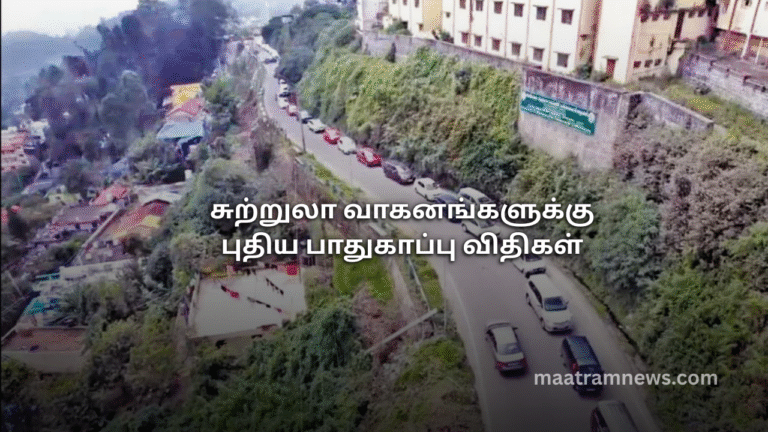சுற்றுலா வாகனங்களுக்கு புதிய பாதுகாப்பு விதிகள்
எல்ல- வெள்ளவாய பள்ளத்தாக்கில் பேருந்து ஒன்று வீழ்ந்து விபத்துக்குள்ளானதை அடுத்து, விபத்துக்களை தடுக்க அரசாங்கம் முனைந்து வருகிறது.
இதன்கீழ் அதற்காக அமைக்கப்பட்ட நிபுணர் குழுவின் இறுதி அறிக்கை வெளியிடப்பட்டு, அதில் பரிந்துரைகளும் முன்வைக்கப்பட்டுள்ளன.
இதன்படி, சுற்றுலாப் பயணத்துக்கு முன்னர் வாகன உரிமையாளர்கள் மற்றும் சுற்றுலா ஏற்பாட்டாளர்கள், பயணிகள் மற்றும் சுற்றுலா ஏற்பாட்டாளர்களின் தேவைகளையும் பாதுகாப்பையும் உறுதி செய்யும் வகையில், ஒரு விரிவான பயணத்திட்டத்தை முன்கூட்டியே சமர்ப்பித்து, தொடர்புடைய அமைப்பிடமிருந்து அனுமதி பெற வேண்டும் என பரிந்துரைக்கப்பட்டுள்ளது.
நாட்டில் சிறப்புச் சுற்றுலா வாகனங்களை முறைப்படுத்துவதற்கு எனத் தனி அமைப்பு எதுவும் இல்லை.
இதனை கருத்திற்கொண்டு, இந்தப் பணியை மேற்கொள்வதற்காக, தேசிய போக்குவரத்து ஆணையகம் அல்லது பயணிகள் போக்குவரத்து ஆணையம் போன்ற ஒரு புதிய அமைப்பு நிறுவப்பட வேண்டும் என்று பரிந்துரையை குறித்த குழு முன்வைத்துள்ளது.
அனைத்துச் சுற்றுலா வாகனங்களும் இந்த அமைப்பில் பதிவு செய்யப்பட வேண்டும்.
அவை அந்த அமைப்பின் விதிமுறைகளுக்குக் கட்டுப்பட வேண்டும்.
பயணத்தின் போது, ஒவ்வொரு ஏழரை மணி நேரப் பயணத்திற்குப் பிறகும், ஓட்டுநருக்கு உணவு மற்றும் ஓய்வுக்காக குறைந்தபட்சம் அரை மணி நேரம் ஓய்வு அளிக்கப்பட வேண்டும்.
ஒவ்வொரு 24 மணி நேரப் பயணத்திற்கும் பிறகு, ஓட்டுநருக்குக் குறைந்தபட்சம் 10 மணி நேரத் தொடர் ஓய்வு அளிக்கப்பட வேண்டும்.
ஓட்டுநர், பயணிகள், மற்றும் வாகனத்தின் உட்புறம் மற்றும் வெளிப்புறத்தைக் கண்காணிப்பதற்காக, பாதுகாப்பு கேமரா அமைப்புகள் நிறுவப்பட வேண்டும்.
ஒரு தகுதியான நிரந்தர ஓட்டுநரும் மற்றும் சில உதவி ஓட்டுநர்களும் வாகனத்துக்காக பெயரிடப்பட வேண்டும்.
ஒரு நாளில் நீண்ட தூரம் பயணிக்கும் பயணங்களுக்கு, நிரந்தர ஓட்டுநருடன் கூடுதலாகப் பெயரிடப்பட்ட ஒரு உதவி ஓட்டுநர் பணியமர்த்தப்பட வேண்டும்.
ஒவ்வொரு நாளும் பயணம் தொடங்குவதற்கு முன், ஓட்டுநர் ஒரு சரிபார்ப்புப் பட்டியலின்படி, வாகனத்தின் அடிப்படை ஆய்வுகளைச் செய்து, வாகனம் இயக்கத்திற்குத் தகுதியானது என்பதை சான்றளிக்க வேண்டும்.
புதிய ஓட்டுநர்கள் பயணிக்கும் வீதிகள் மற்றும் அதன் அபாயகரமான பகுதிகள் குறித்து விழிப்புடன் இருக்க, பயணத்தைத் தொடங்குவதற்கு முன், ஒரு வழிகாட்டுதல் வரைபடத்தை அவர்களுக்கு காட்டவேண்டும்.
இதன் மூலம், ஓட்டுநர்கள் அபாயகரமான பகுதியின் தூரம், வீதியின் தன்மை மற்றும் வளைவுகள் போன்றவற்றை முன்கூட்டியே புரிந்துகொள்ள முடியும்.
மேலும், கண்டி, நுவரெலியா போன்ற அபாயகரமான வீதி பகுதியில் உள்ள ஒவ்வொரு வளைவுக்கும் எண் குறியீடுகள் வழங்கப்பட வேண்டும்.
இந்த எண் குறியீடுகள் மற்றும் எச்சரிக்கை பலகைகள் அந்தந்த வளைவுகளுக்கு அருகில் நிறுவப்பட வேண்டும்.
இதன் மூலம், ஓட்டுநர்கள் எந்த வளைவில் இருக்கிறார்கள், மேலும் எத்தனை வளைவுகள் உள்ளன என்பதைப் பற்றிய தெளிவான புரிதலைப் பெறுவார்கள்.
இந்தத் தகவல், அடுத்து வரும் வளைவுகளுக்குத் தயாராவதற்கும், விபத்துகளைத் தவிர்ப்பதற்கும் உதவும் என்று நிபுணர் குழுவின் அறிக்கை பரிந்துரைக்கிறது.
மேலதிக தகவல்களுக்கு மாற்றம் செய்திகள் இணையத்தளத்தினுள் பிரவேசியுங்கள்.
மேலதிக தகவல்களை உடனுக்குடன் பெற்றுக்கொள்ள மாற்றம் செய்திகள் முகநூல் பக்கத்தை பின்தொடரவும்.
New Safety Regulations for Tourist Vehicles
Following a bus accident in the Ella-Vellawaya valley, the government has stepped in to prevent such accidents in the future.
Under this initiative, the expert committee formed for this purpose has released its final report, which includes several recommendations.
Accordingly, before a tourist trip, vehicle owners and tour operators, as well as travelers, must submit a comprehensive travel plan in advance and obtain approval from the relevant authority. This ensures the safety and needs of both travelers and tour organizers.
Currently, there is no dedicated authority in the country to regulate special tourist vehicles.
Considering this, the committee has recommended the establishment of a new body, such as a National Transport Authority or Passenger Transport Commission, to manage this task.
All tourist vehicles must be registered with this authority and adhere to its regulations.
During travel, drivers must be given a minimum rest period of 30 minutes for food and relaxation after every seven hours of driving.
After every 24 hours of travel, the driver must be given a continuous rest period of at least 10 hours.
Security camera systems must be installed to monitor the driver, passengers, and both the interior and exterior of the vehicle.
A qualified permanent driver, along with a few assistant drivers, must be assigned to each vehicle.
For long-distance trips, in addition to the permanent driver, an extra assistant driver must be appointed.
Before starting each day’s journey, the driver must conduct a basic vehicle inspection using a checklist and certify that the vehicle is fit for operation.
New drivers must be shown a guidance map before starting the journey so that they are aware of the routes and any dangerous sections in advance. This allows drivers to understand the distance, nature, and curves of hazardous areas ahead of time.
Furthermore, each curve on dangerous routes, such as in Kandy and Nuwara Eliya, should be assigned a number.
These numbered indicators and warning signs must be installed near the respective curves. This will give drivers a clear understanding of their current position and the number of curves ahead.
The expert committee’s report recommends that this information will help drivers prepare for upcoming curves and prevent accidents.



